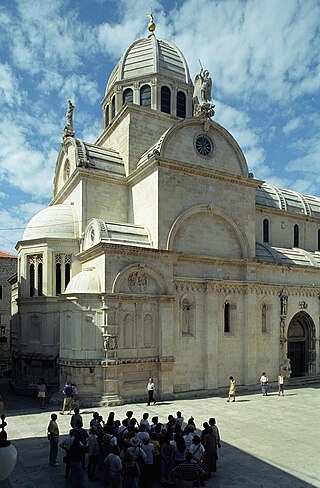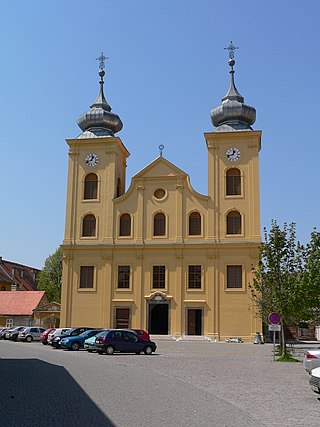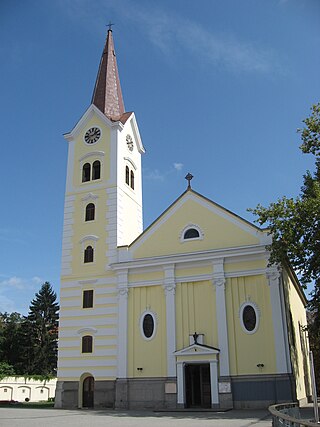
Koprivnica is a city in Northern Croatia, located 70 kilometers northeast of Zagreb. It is the capital and the largest city of Koprivnica-Križevci County. In 2011, the city's administrative area of 90.94 km2 had a total population of 30,854, with 23,955 in the city proper.

The Zagreb Cathedral, is a Catholic cathedral in Kaptol, Zagreb. It is the second tallest building in Croatia and the most monumental sacral building of Gothic architecture southeast of the Alps.
The history of Zagreb, the capital and largest city of Croatia, dates back to the Middle Ages. The Romans had built a settlement, Andautonia, in present-day Ščitarjevo. The name "Zagreb" was first used in 1094 at the founding of the Zagreb diocese in Kaptol, after the Slavs had arrived in the area. Zagreb became a free royal city in 1242. It was made the capital of Croatia in 1845 and elected its first mayor, Janko Kamauf, in 1851. According to the 2011 Croatian census, Zagreb had 792,875 inhabitants and was also Croatia's largest city by area.

The Assumption Cathedral is a Roman Catholic cathedral in Dubrovnik, Croatia. It is the seat of the Diocese of Dubrovnik.

The architecture of Croatia has roots in a long history: the Croats have inhabited the area for fourteen centuries, but there are important remnants of earlier periods still preserved in the country. The historic architecture of most old towns on the coast is Venetian, a legacy of the Venetian empire. The Habsburg and Ottoman empires also influenced the architecture of the region.
Croatian art describes the visual arts in Croatia, and art by Croatian artists from prehistoric times to the present. In Early Middle Ages, Croatia was an important centre for art and architecture in south eastern Europe. There were many Croatian artists during the Medieval period, and the arts flourished during the Renaissance. Later styles in Croatia included Baroque and Rococo.

The Church of St. Donatus is a Catholic church located in Zadar, Croatia. Its name refers to Donatus of Zadar, who began construction on this church in the 9th century and ended it on the northeastern part of the Roman forum.

The Church of St Peter and St Paul, the co-cathedral of the Roman Catholic Archdiocese of Đakovo-Osijek, is a neo-Gothic sacral structure located in Osijek, Croatia. The multi-tiered 90-metre spire is one of the city's landmarks. The church was built in 1898 on the initiative of the Bishop of Đakovo Josip Juraj Strossmayer.

The Cathedral of the Transfiguration of the Lord is a Serbian Orthodox cathedral located on the Petar Preradović Square in Zagreb, Croatia. It was built in 1865–66 according to designs of architect Franjo Klein. It is ecclesiastically part of the Metropolitanate of Zagreb and Ljubljana and is known as the Zagreb Orthodox Cathedral. Due to 2020 Zagreb earthquake the Cathedral went to re-construction due to mayor damages that occurred.

Bribir is a village in Šibenik-Knin County, near the town of Skradin, in southern Croatia. In its location in the Roman period was town Varvaria, while during the medieval times it was an important and rich settlement with a stronghold and Franciscan monastery, a capital city of power of the Šubić family.

The Church of St. Mark is the parish church of old Zagreb, Croatia, located in St. Mark's Square. It is one of the oldest architectural monuments in Zagreb.

Church of St. Nicholas in Vukovar is a Serbian Orthodox church in eastern Croatia. The church is one of the oldest baroque buildings of the Serb community north of the Sava River.

The Church of Saint Michael is a Roman Catholic church in Osijek, Croatia. It is located in Tvrđa.

Cathedral of Exaltation of the Holy Cross is a cathedral in the Diocese of Sisak. It is located in the center of Sisak on Ban Jelačić Square.

Cathedral of Teresa of Ávila in Bjelovar is the baroque church of Diocese of Bjelovar-Križevci. It is located in the center of the town of Bjelovar, Croatia, on Eugen Kvaternik Square. Until 2009, when it became a cathedral, it was parish church.

The Greek Catholic Co-cathedral of Saints Cyril and Methodius is the historicistic co-cathedral church of the Greek Catholic Eparchy of Križevci. It belongs to the Vicariate of Diocese of Žumberak-Križevci. It is located in the Street of St. Cyril and Methodius on the Upper Town in Zagreb, near St. Mark's Square.
Ivan Krstitelj Tkalčić was a Croatian historian, Catholic priest, and prebendary.

The Basilica of the Heart of Jesus is a Roman Catholic basilica located in Palmotićeva street of Zagreb, Croatia. It is dedicated to the Sacred Heart, and was designed by the Croatian architect Janko Holjac in the neo-Baroque style.

Church of Saint Blaise is a Catholic parish church located in the Lower Town of Zagreb, Croatia. It is dedicated to the Saint Blaise, and was designed by the Croatian architect Viktor Kovačić in the eclectic style. It is notable for its cuppola, made out of reinforced concrete, first of its kind in the region.

The Collegium Ragusinum, sometimes also Rhagusinum, was the Jesuit college in the Republic of Ragusa, now the city of Dubrovnik in Croatia. Following early Jesuit presence in Ragusa in the late 1550s, the college was established in 1658 and closed in 1773 with the suppression of the Society of Jesus. Its preserved church is dedicated to Saint Ignatius, and the other buildings now host a Catholic gymnasium and other Church facilities. The complex has been referred to as "considered to be the finest Baroque set of buildings in Dubrovnik, and - according to many - in all of Dalmatia."

























